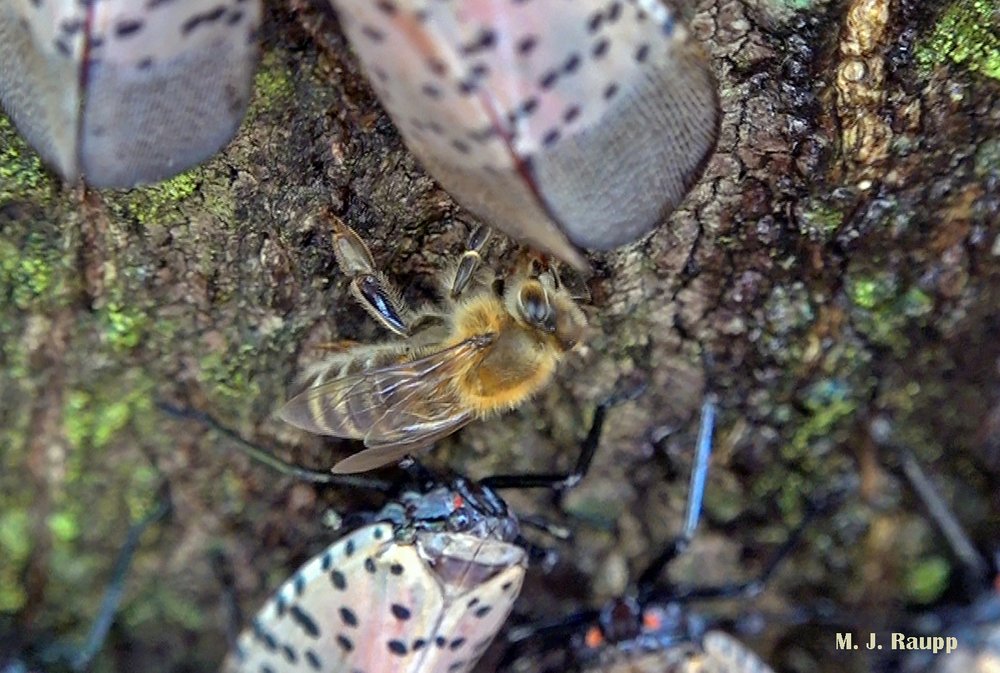Honeydew for honey bees? Spotted lanternflies, Lycorma delicatula

This little honeybee seems to know exactly where the honeydew will appear.
Back in September we visited spotted lanternflies as they continued their spread across the eastern United States. In the intervening weeks, several counties in Maryland, West Virginia, New York, New Jersey, and Massachusetts have reported new breeding populations of lanternflies. Recently, we visited infestations in Maryland and Virginia and were astounded not only by the sheer numbers of lanternflies but also by the gushing volumes of honeydew produced by adult lanternflies feeding on the bark of trees. On a bright sunny day in northern Virginia while admiring a throng of these rascally pests in a stand of Ailanthus trees, we were showered by a steady rain of lanternfly honeydew.
Phloem sap is a rich source of carbohydrates for many types of sucking insects, including spotted lanternflies. Large quantities of sap are processed to extract nutrients and the excess fluid is excreted as a liquid waste called honeydew. With hundreds or thousands of lanternflies feeding and expelling honeydew, one can experience rain on a sunny day while standing beneath an infested tree.
While honeydew sometimes refers to a tasty brand of doughnuts or delicious type of melon, in ento-speak honeydew is the sugar-rich liquid waste of sucking insects like aphids, scales, and lanternflies that squirts from their anus. Honeydew is derived from a vascular tissue of plants called phloem which many sucking insects consume. Earlier this year we met another sucking insect, the cicada, that feeds on a different vascular tissue called xylem. Cicadas process great volumes of xylem fluid and excrete copious amounts of watery liquid waste, creating a gentle shower beneath trees on which they congregate and feed. Previously, we reviewed the serious economic threat spotted lanternflies pose to grape growers, orchardists, and the general public, whose lanternfly-infested trees could be fouled by lanternfly honeydew. Economic losses associated with lanternflies in Pennsylvania are currently estimated to exceed more than 50 million dollars annually and are expected to only increase as lanternflies spread.
As we stood in a gentle honeydew shower, we were chagrined by the diversity and number of stinging insects taking advantage of the sugary bounty provided by lanternflies. Paper wasps, yellowjackets, and hornets greedily collected and often battled over droplets of honeydew. Some even waited near the rear-end of lanternflies, apparently for fresh deliveries. One happy visitor to the honeydew bonanza was our friend the industrious honey bee. As the day warmed and lanternflies amped up honeydew production, growing numbers of honey bees were recruited to this rich sugar source. This may be some good news for our beleaguered bee friends. There is growing concern that honey bees face a dearth of nectar and pollen food sources, especially late in the growing season in temperate regions of our land. Perhaps honeydew produced by spotted lanternflies can serve as a novel carbohydrate source for our struggling bees. Wouldn’t it be nice if spotted lanternfly, an invasive pest, provided some lemonade and not just lemons in its new home here in the US?
Honeydew excreted by spotted lanternfly creates a nuisance around infested trees when stinging wasps and bees gather to collect this sweet source of food. But does this honeydew serve as a useful food resource for honey bees?
Acknowledgements
Bug of the Week thanks Sally, Tim, and Mark for providing inspiration for this episode. Special thanks to the great crew of entomologists at Penn State and Virginia Tech working to quell the spotted lanternfly invasion. The interesting articles “Scientists Examine Potential Economic Impact of Spotted Lanternfly in Pennsylvania” by Amy Duke, and “Native habitat mitigates feast–famine conditions faced by honey bees in an agricultural landscape” by Adam G. Dolezal, Ashley L. St. Clair, Ge Zhang, Amy L. Toth, and Matthew E. O’Neal were consulted in preparation for this episode.
This post appeared first on Bug of the Week